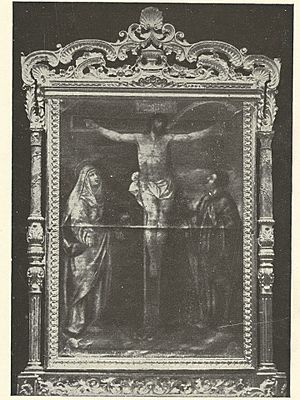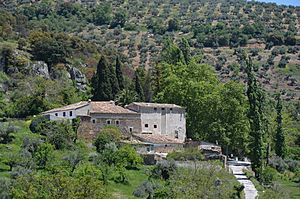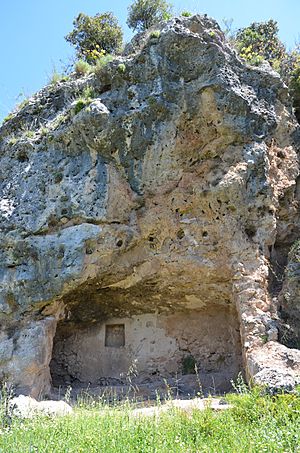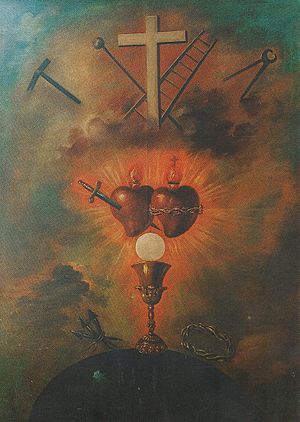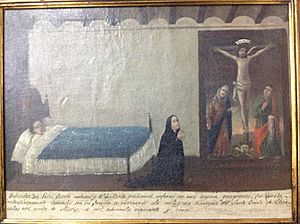Cristo de Chircales facts for kids
Quick facts for kids Cristo de Chircales |
|
|---|---|
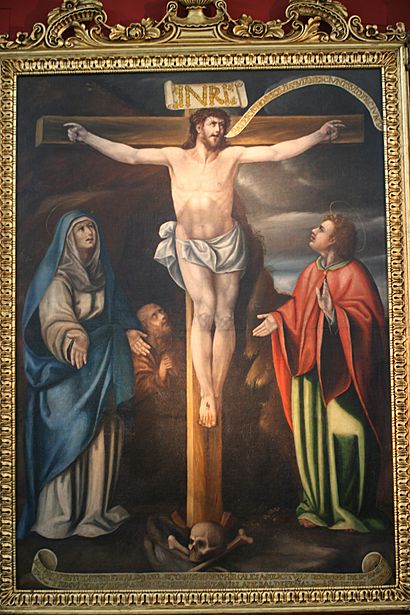 |
|
| Artist | unknown |
| Year | 16th century |
| Type | Oil |
| Location | Valdepeñas de Jaén |
The Cristo de Chircales, also known as the Santísimo Cristo de Chircales, is an old oil painting. It was made by an artist whose name we don't know. This painting is kept in a special church called the Sanctuary of the Holiest Christ of Chircales. This church is located near Valdepeñas de Jaén, Spain. The painting was created in the 16th century.
The painting shows a scene called a Calvary. This is where Jesus Christ is shown on the cross. You can also see the Virgin Mary and Saint John the Evangelist. There is also a person kneeling at the feet of Christ. Some people think this person is a hermit, which is someone who lives alone for religious reasons. Others believe it is Saint Peter.
This painting is very important to the people of Valdepeñas de Jaén. It is the main religious symbol in the area. Many groups, called brotherhoods, have been formed to honor it. Two of these brotherhoods still exist today. One was started in Valdepeñas de Jaén in 1834. The other was founded in Jaén in 1867.
The painting's special day is September 2nd. This is a local holiday in Valdepeñas de Jaén. Also, on the first Sunday of May, people go on a popular pilgrimage to honor the painting. A pilgrimage is a journey to a holy place. This pilgrimage is so important that it has been named an "Immaterial Patrimony of Andalusia." This means it's a valuable part of the region's culture and traditions.
Contents
What the Painting Shows
The painting shows the scene of Calvary. This is where Jesus Christ is on the cross. At his feet, there are three other people. On the left side, you can see the Virgin Mary. On the right side is Saint John.
At the very bottom of the cross, there is a figure that is a bit hard to see. For a long time, people thought this was a hermit. A hermit is someone who lives a simple life, often alone, for religious reasons. However, newer studies suggest it might be Saint Peter. This idea comes from an old record from 1620. This record describes the painting as having "Christ crucified with Our Lady and Saint John and Saint Peter at the feet." This makes the painting even more interesting!
A Look at Its History
The history of Valdepeñas de Jaén is closely connected to the Cristo de Chircales painting. When the town was founded in 1539, people started to visit the Chircales area more often. This area was home to a group of hermits. These hermits lived in caves in the valley.
Over time, people started to give money and support to help keep Christian worship alive in this place. The Sanctuary gained resources to continue its work. By the mid-16th century, a group of hermit priests lived in Chircales. They were connected to a religious school. These priests helped build and improve the Sanctuary, both physically and spiritually.
They decided to build the church that stands today. They also added other buildings to welcome visitors. To make the Sanctuary more beautiful, they likely asked for the Cristo de Chircales painting to be made. The painting's theme was very important to the religious beliefs of the time.
The first official mention of the painting was in 1609. It was listed in an inventory of items owned by the church. This list was ordered by a bishop named Sancho Dávila Toledo.
In 1751, the painting was changed a bit to add two special messages. These messages were added to a fancy Baroque frame. The bottom message says: "This endorsement of the Blessed Christ of Chircales was endowed and painted at the request from Mr. Basilio Fajardo, priest and other benefactors of the town of Baldepeñas. Year 1751." The top message, coming from Christ's face, says in Latin: "Pater ygnosce illis quia nesciunt quid faciunt." This means: "Father, forgive them because they do not know what they do."
How People Show Devotion
The Cristo de Chircales is deeply loved in Valdepeñas de Jaén and the surrounding region. It is the most important religious devotion there. Since the 17th century, the painting was sometimes brought to Valdepeñas de Jaén. This usually happened when there were sicknesses or bad weather.
Since the 19th century, especially after a serious illness in 1834, the painting started to visit Valdepeñas de Jaén more often. By the end of that century, it became a yearly tradition. The painting stays in the town from September 1st until the last Sunday of October. Then it is taken back to its Sanctuary. People in many nearby towns have also shown great devotion to the Cristo de Chircales. Many brotherhoods were formed in its honor.
In 1834, during a serious illness, some people from a street in Valdepeñas de Jaén prayed to the Cristo de Chircales. They promised to hold a religious festival if they were spared. Since they survived, they kept their promise. Around 1855, this devotion led to the creation of a Brotherhood. This group took care of the local devotion to the Cristo de Chircales. Today, it is the only official Brotherhood in the town.
In the city of Jaén, devotion to the Cristo de Chircales was also very strong. There is still a Brotherhood there today. It is based in the Parish of San Juan de la Cruz. This Brotherhood has had rules since 1867. It was originally based in the Church of St. Bartholomew. The Brotherhood was reorganized in 1985. They take part in the religious festivals in Valdepeñas de Jaén every year. They also celebrate their own events in Jaén.
In Martos, there is a copy of the Cristo de Chircales painting. This copy was made in the 19th century. It is displayed in the Hermitage of San Miguel. This painting belonged to a man named Don Antonio de la Torre Arias, who was a great admirer of the image. It was once in his home, then in his family tomb, and later in a church. Now, it is in the Hermitage of San Miguel.
In Alcaudete, many people have traditionally been devoted to the Cristo de Chircales. Even today, there is a farmhouse called 'Chircales' that used to belong to the painting's followers. This farmhouse has a small chapel dedicated to the Cristo de Chircales. A popular pilgrimage used to be held there. The name Chircales is also used for a large area in the municipality of Alcaudete.
In Jamilena, there is also evidence of devotion to the Cristo de Chircales. People from Jamilena often went on pilgrimages to its Sanctuary. In 1798, a man from Jamilena named Cristóbal Barranco Liébana died in an accident at the Sanctuary. He was buried in the Sanctuary's church.
In Torredonjimeno, you can also find stories about the historical devotion to the Cristo de Chircales. Some special paintings were given to the Sanctuary by faithful people from Torredonjimeno. One of these paintings has an inscription from 1856. It says that a woman named Francisca de Rada was very sick. Her mother, María de los Dolores Lendínez, prayed to the Santísimo Cristo de Chircales for her daughter's health. Francisca then became completely well. This sick woman was from Torredonjimeno.
Images for kids
See also
 In Spanish: Cristo de Chircales para niños
In Spanish: Cristo de Chircales para niños


